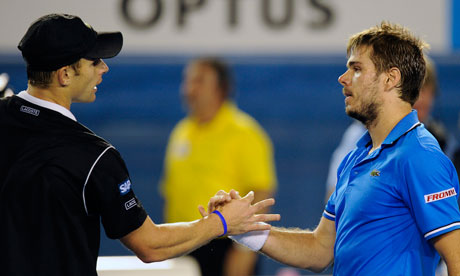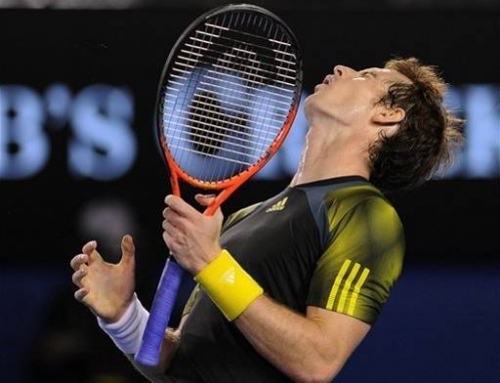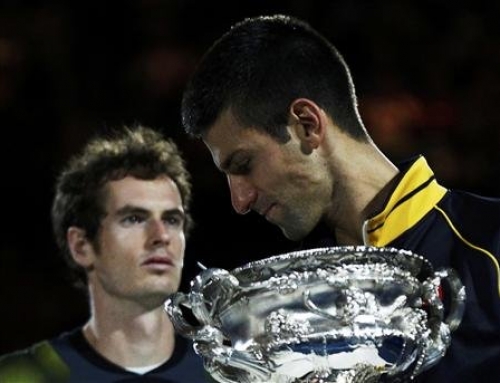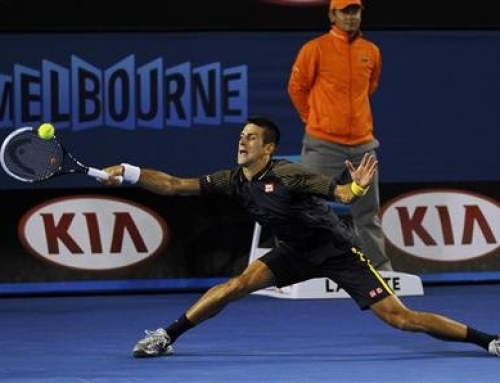 Stan Wawrinka reached the top ten a few years ago, but has since dropped in the rankings to about 20 in the world. A little over a year ago, he married a Swiss TV presenter and former fashion model. She gave birth to their daughter. And shortly afterwards, Wawrinka chose to leave his wife (and child) and switch coaches to Peter Lundgren, and rededicate himself to tennis. Whether his actions should be derided or not, one thing seems to have happened. His rededication to tennis has already lead to good results on the court.
Stan Wawrinka reached the top ten a few years ago, but has since dropped in the rankings to about 20 in the world. A little over a year ago, he married a Swiss TV presenter and former fashion model. She gave birth to their daughter. And shortly afterwards, Wawrinka chose to leave his wife (and child) and switch coaches to Peter Lundgren, and rededicate himself to tennis. Whether his actions should be derided or not, one thing seems to have happened. His rededication to tennis has already lead to good results on the court.
Wawrinka beat Monfils in the previous round, up-and-comer Grigor Dmitrov in the previous round, and Gabashvili in the round before, all without dropping a set.
Oddsmakers were giving Wawrinka the slight edge to win this match, perhaps given his wins over superior opponents. Those among the tennis cognoscenti felt that Roddick’s game was a bit passive. Gone are the days when Roddick would bomb in 20 aces a game. Gone are the days when Roddick used to hit laser forehands for winners. His current modus operandi is to get in long rallies where he hits hard enough to prevent his opponents from attacking and hope for the error.
Part of the reason for this strategy appears to be a fear of going for big shots, especially down the line. Occasionally, when Roddick plays someone with firepower, he resorts to hitting harder, but the results sometimes ends up in more errors. Former Davis Cup Captain said that Roddick may need to revisit his game and learn to hit these power shots, but that his desire to stay in the top ten may be preventing him from taking such a gamble this late in his career.
The final score says Wawrinka won 6-3, 6-4, 6-4. But this doesn’t begin to tell the kind of beatdown that Wawrinka put on Roddick.
Wawrinka served 24 aces to Roddick’s 9 aces. He finished with around 60 winners, many coming off his backhand. Once the two got in a rally, Wawrinka would eventually hit a big shot and win the point. In a very early game in the first set, Roddick was trying to save break point after break point. Eventually he lost serve, and it spoke volumes to how the rest of the match would turn out.
Despite the convincing win, the ESPN commentators felt that Wawrinka’s quarterfinal match with Federer would be a different story. As much as Wawrinka is playing his best tennis in some time, he’s playing Federer, not Roddick. They said that how a player plays depends very much on what the opponent does. Federer is not only more aggressive than Roddick and Monfils, he’s also the number 2 in the world, and has a great head-to-head over Wawrinka. Still, Wawrinka has to believe he’s playing well enough to give Federer trouble, especially since Fed dropped another set to Tommy Robredo, another player that might be seeing a renaissance in his game.
Federer may be fortunate. Robredo plays a one-handed backhand style, much like Wawrinka, although Robredo seems to spin the ball a bit more while Wawrinka tends to drive the ball more. It’s hard to say whether Wawrinka’s ace count means much. Roddick is susceptible to being aced a lot. The return is not the best part of his game. Wawrinka hit 11 aces against Monfils, but 24 against Roddick.
Meanwhile, now that Roddick is healthy and playing better tennis, the question is whether he should continue his style of play, one that doesn’t allow him to dictate points on his terms, or whether he decides to revamp his style and play higher risk tennis. Roddick knows his current style works fine against most players outside the top 10, but there’s a sense that 2011 might signal a changing of the guards where players that were seed as talented but erratic (Tomas Berdcyh), and new players (Raonic, Tomic, and Dimitrov) might start climbing up the ranks.
Roddick has stayed in the top ten for the better part of a decade. It’s an accomplishment he’s proud of. Certainly, Lleyton Hewitt wasn’t able to do that, nor David Nalbandian. And some players have seen late resurgences, like Davydenko and Melzer. What will Roddick do now?






![[Aussie Open Final] Can Andy Murray beat Novak Djokovic?](https://www.essentialtennis.com/wp-content/uploads/2013/01/20130126andy-500x383.jpg)
![[Day 13, Aussie Open] Bryan brothers win 13th Slam with Aussie doubles title, Kyrgios wins boys title](https://www.essentialtennis.com/wp-content/uploads/2013/01/20130125bryan-500x383.jpg)